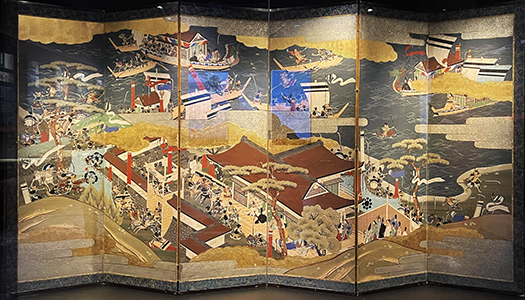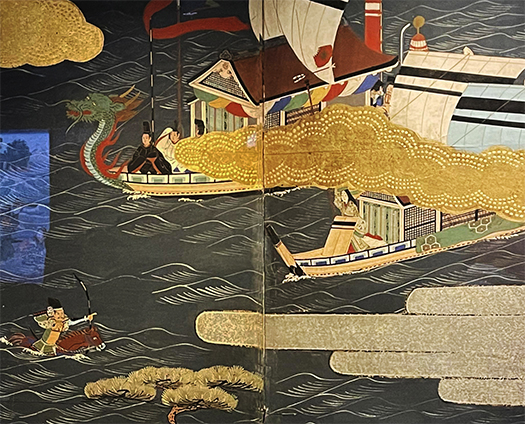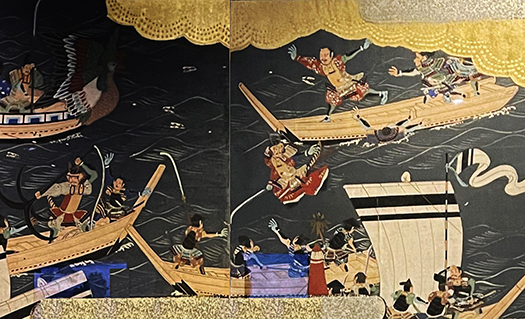
さて昨日まで3回にわたって鎌倉歴史文化交流館の建築について解剖しました。非常に興味深い建築ですが、その建築の現在の使用目的は「歴史博物館」機能。交流館の各展示はほぼすべて写真撮影・公開許諾されている。いやむしろ積極的に情報発信を推奨されている。本日からはその展示内容をもとに歴史世界に耽溺したいと思います。上の写真は展示中心場所に置かれた「源平合戦図屏風」で制作年代は江戸後期。
日本史の中で畿内地域が長く中心地域であったのに対して、列島最大の平野部を有する関東地域は弥生文化、稲作農業主体の社会開発はやや遅れて始まった。
開拓初期は毛野(群馬栃木)地域が中心。ヤマトタケル遠征での歌詠みで「あずま」という地名が読まれたりした。中央政権側からすれば遠隔地であり「東夷〜あずまえびす」という地域蔑称が語られたりした。
そういった差別的な中央への表立った反乱の嚆矢は平将門の乱。904年に起こって関東の政治主権主張が開始した。それに引き続いて1051年以降の前九年合戦など奥州動乱が連動した。武士の勃興とは、こういう東国東北地域での武力対立の先鋭化が背景にあったのだろう。
雅やかな支配構造である王朝政権に対して土地争奪のリアリズム世界・東国としては、武力優先による支配志向が高まったのだと思える。そういう武力権力の確立に際して「旗頭」貴種として源頼義以降の源氏一族が、この鎌倉を本拠地として選択し地域武士層の盟主となっていった。
さまざまな経緯の末に、頼朝の代になってこうした関東武士との関係が強化発展して出来上がっていったのが鎌倉幕府。神武東征やヤマトタケルの全国支配示威などにも比肩するような日本史上での「権力の発生」がこの鎌倉で起こった。独自権力の樹立では未遂に終わった平将門の乱を教訓化して、慎重に権力を樹立していったのが頼朝と御家人たちの体制だった。
その経緯に踏まえれば源平合戦は東国・鎌倉の新時代を切り開く戦役だった。その主役のひとりだった義経はしかし兄・頼朝ほどの政治洞察力を持たなかったことで悲劇のヒーロー化した。そこには畿内・西国地域の「常識世論」と鎌倉武権とのあつれきが凝縮されてもいるのだろうか。


この写真は源平合戦図屏風の部分拡大。屏風絵なので絵は複数の部分に分割されているのですが、Photoshopで切り抜いたり補正したりして作成しました(笑)。源平合戦での2つの主要合戦譚「那須与一の扇の図と、壇ノ浦での義経の「八艘飛び」場面の情景描写部分。
屏風絵に対してこのように画像処理作業をしていると表現のディテールもなんとなくわかってくる部分があって、楽しみも深まる部分があります。一部にはどうしても館内照明が保護ガラス面に映り込んでいますが、そこは無視して(笑)ごらんください。
English version⬇
Indulging in the Genpei War Folding Screen: History of Kamakura-4
The lady who held up a fan to Nasu Yoichi must have been terrified, and the painting depicts Yoshitsune protected by a shield and jumping eight boats in a superhuman leap (laugh).
Well, yesterday I dissected the architecture of the Kamakura History and Culture Exchange Center over the course of three articles. It is a very interesting building, but the current use of the architecture is for its “history museum” function. Almost all of the exhibits in the exchange center are permitted to be photographed and opened to the public. Or rather, they are actively encouraged to disseminate information. From today, I would like to indulge in the world of history based on the contents of those exhibits. The photo above is “Genpei Gassen Zu Byobu” placed at the central location of the exhibition, dated in the late Edo period.
While the Kinai region has long been the central region in Japanese history, the Kanto region, which has the largest plains in the archipelago, was somewhat late in developing a society based on the Yayoi culture and rice agriculture.
In the early days of settlement, the main area was the Mono (Gunma-Tochigi) region. The name “Azuma” was sometimes read in poems composed during Yamatotakeru’s expedition. From the perspective of the central government, it was a remote area, and a derogatory term for the area, “Azuma-ebisu,” was sometimes used.
The pioneering example of such discriminatory rebellion against the central government was the Taira-no-Masakado Rebellion of 904, which marked the beginning of the assertion of political sovereignty in the Kanto region. This was followed by the Oshu uprisings of 1051 and later, such as the Mae-no-Kunen Gassen. The rise of the samurai was probably due to the sharpening of armed conflict in the northeastern region of the eastern provinces.
In contrast to the dynastic government, which had an elegant ruling structure, the realistic world of the East, with its land disputes, was increasingly oriented toward domination by military force. In establishing such military power, the Minamoto clan, from Minamoto no Yoriyoshi onward, chose Kamakura as their home base and became the leader of the local warrior class.
After a variety of circumstances, the Kamakura shogunate was established by Yoritomo’s generation as a result of the strengthening and development of relations with these Kanto warriors. In Kamakura, the “emergence of power” in Japanese history, which is comparable to the Jinmu expedition and the demonstration of Yamatotakeru’s control over the whole country, took place. Learning a lesson from the Taira-no-Masakado Rebellion, which ended in an unsuccessful attempt to establish their own power, Yoritomo and his retainers carefully established their power.
Based on this history, the Genpei War was a battle that ushered in a new era in the eastern provinces of Japan and Kamakura. Yoshitsune, who played a leading role in the battle, became a tragic hero because he did not have the same political acumen as his elder brother Yoritomo. This may be a condensation of the conflict between the “common sense public opinion” of the Kinai and Western provinces and the Kamakura military authority.
This photo is an enlargement of a portion of the Genpei Gassen Byobu. Since it is a folding screen painting, the picture is divided into several parts, but I created it by cropping and correcting in Photoshop (see below). The two main battle tales in the Genpei wars: “Nasu Yoichi’s Fan” and the scene of Yoshitsune’s “Hachisou jump” scene at Dannoura.
When we process images of folding screen paintings like this, we can understand some of the details of the expression, which deepens the enjoyment of the work. Some of the lighting in the museum is inevitably reflected on the protective glass surface, but please ignore that (laugh) and enjoy the view.
Posted on 4月 8th, 2023 by 三木 奎吾
Filed under: 歴史探訪







コメントを投稿
「※誹謗中傷や、悪意のある書き込み、営利目的などのコメントを防ぐために、投稿された全てのコメントは一時的に保留されますのでご了承ください。」
You must be logged in to post a comment.